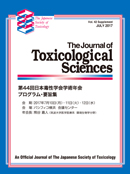The 47th Annual Meeting of the Japanese Society of Toxicology
Displaying 101-150 of 469 articles from this issue
Symposium 22
-
Session ID: S22-3
Published: 2020
Released on J-STAGE: September 09, 2020
Download PDF (148K) -
Session ID: S22-4
Published: 2020
Released on J-STAGE: September 09, 2020
Download PDF (133K) -
Session ID: S22-5
Published: 2020
Released on J-STAGE: September 09, 2020
Download PDF (144K) -
Session ID: S22-6
Published: 2020
Released on J-STAGE: September 09, 2020
Download PDF (144K) -
Session ID: S22-7
Published: 2020
Released on J-STAGE: September 09, 2020
Download PDF (153K)
Symposium 23
-
Session ID: S23-1
Published: 2020
Released on J-STAGE: September 09, 2020
Download PDF (118K) -
Session ID: S23-2
Published: 2020
Released on J-STAGE: September 09, 2020
Download PDF (49K) -
Session ID: S23-3
Published: 2020
Released on J-STAGE: September 09, 2020
Download PDF (72K) -
Session ID: S23-4
Published: 2020
Released on J-STAGE: September 09, 2020
Download PDF (74K)
Symposium 24
-
Session ID: S24-1
Published: 2020
Released on J-STAGE: September 09, 2020
Download PDF (131K) -
Session ID: S24-2
Published: 2020
Released on J-STAGE: September 09, 2020
Download PDF (173K) -
Session ID: S24-3
Published: 2020
Released on J-STAGE: September 09, 2020
Download PDF (200K) -
Session ID: S24-4
Published: 2020
Released on J-STAGE: September 09, 2020
Download PDF (204K)
Symposium 25
-
Session ID: S25-1
Published: 2020
Released on J-STAGE: September 09, 2020
Download PDF (147K) -
Session ID: S25-2
Published: 2020
Released on J-STAGE: September 09, 2020
Download PDF (158K) -
Session ID: S25-3
Published: 2020
Released on J-STAGE: September 09, 2020
Download PDF (165K) -
Session ID: S25-4
Published: 2020
Released on J-STAGE: September 09, 2020
Download PDF (163K)
Symposium 26
-
Session ID: S26-1
Published: 2020
Released on J-STAGE: September 09, 2020
Download PDF (175K) -
Session ID: S26-2
Published: 2020
Released on J-STAGE: September 09, 2020
Download PDF (175K) -
Session ID: S26-3
Published: 2020
Released on J-STAGE: September 09, 2020
Download PDF (169K) -
Session ID: S26-4
Published: 2020
Released on J-STAGE: September 09, 2020
Download PDF (160K)
Symposium 27
-
Session ID: S27-1
Published: 2020
Released on J-STAGE: September 09, 2020
Download PDF (157K) -
Session ID: S27-2
Published: 2020
Released on J-STAGE: September 09, 2020
Download PDF (87K) -
Session ID: S27-3
Published: 2020
Released on J-STAGE: September 09, 2020
Download PDF (143K) -
Session ID: S27-4
Published: 2020
Released on J-STAGE: September 09, 2020
Download PDF (174K) -
Session ID: S27-5
Published: 2020
Released on J-STAGE: September 09, 2020
Download PDF (109K)
Symposium 28
-
Session ID: S28-1
Published: 2020
Released on J-STAGE: September 09, 2020
Download PDF (103K) -
Session ID: S28-2
Published: 2020
Released on J-STAGE: September 09, 2020
Download PDF (155K) -
Session ID: S28-3
Published: 2020
Released on J-STAGE: September 09, 2020
Download PDF (154K) -
Session ID: S28-4
Published: 2020
Released on J-STAGE: September 09, 2020
Download PDF (149K) -
Session ID: S28-5
Published: 2020
Released on J-STAGE: September 09, 2020
Download PDF (184K)
Symposium 29
-
Session ID: S29-1
Published: 2020
Released on J-STAGE: September 09, 2020
Download PDF (178K) -
Session ID: S29-2
Published: 2020
Released on J-STAGE: September 09, 2020
Download PDF (171K) -
Epigenome changes in the offspring affected by the fetal and neonatal environment and their remnantsSession ID: S29-3
Published: 2020
Released on J-STAGE: September 09, 2020
Download PDF (183K) -
Session ID: S29-4
Published: 2020
Released on J-STAGE: September 09, 2020
Download PDF (173K) -
Session ID: S29-5
Published: 2020
Released on J-STAGE: September 09, 2020
Download PDF (159K)
Symposium 30
-
Session ID: S30-1
Published: 2020
Released on J-STAGE: September 09, 2020
Download PDF (167K) -
Session ID: S30-2
Published: 2020
Released on J-STAGE: September 09, 2020
Download PDF (159K) -
Session ID: S30-3
Published: 2020
Released on J-STAGE: September 09, 2020
Download PDF (173K) -
Session ID: S30-4
Published: 2020
Released on J-STAGE: September 09, 2020
Download PDF (177K) -
Session ID: S30-5
Published: 2020
Released on J-STAGE: September 09, 2020
Download PDF (170K)
Symposium 31
-
Session ID: S31-1
Published: 2020
Released on J-STAGE: September 09, 2020
Download PDF (182K) -
Session ID: S31-2
Published: 2020
Released on J-STAGE: September 09, 2020
Download PDF (160K) -
Session ID: S31-3
Published: 2020
Released on J-STAGE: September 09, 2020
Download PDF (157K) -
Session ID: S31-4
Published: 2020
Released on J-STAGE: September 09, 2020
Download PDF (168K) -
Session ID: S31-5
Published: 2020
Released on J-STAGE: September 09, 2020
Download PDF (188K)
Workshop 1
-
Session ID: W1-1
Published: 2020
Released on J-STAGE: September 09, 2020
Download PDF (185K) -
Session ID: W1-2
Published: 2020
Released on J-STAGE: September 09, 2020
Download PDF (187K) -
Session ID: W1-3
Published: 2020
Released on J-STAGE: September 09, 2020
Download PDF (173K) -
Session ID: W1-4
Published: 2020
Released on J-STAGE: September 09, 2020
Download PDF (161K)
